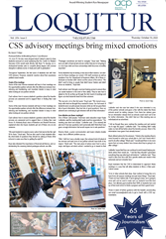
Hoping to humanize immigrants as well as social justice topics concerning immigration of Latinos to the United States was the focus of a speech by author Sonia Nazario. To humanize immigrants was the reason Pulitzer-Prize author Nazario risked her own life. To write the story of 16-year-old Enrique as he made his journey from Honduras to find his mother in the United States, Nazario lived for six months as a migrant herself. Nazario wrote “Enrique’s Journey,” a true story based on a teenage boy’s journey to find his mother in the United States and the struggles and dangers he encountered while on his 14,000-mile migration.
Jumping the trains was only part of the danger. Those who did not fall off the trains and lose arms, legs or their lives had to worry about low-hanging tree limbs, border patrols that would deport illegal riders, and cartels that would kidnap and hold the train-jumpers for ransom, often ending in murder regardless.
“I could see the gangsters knifing people on the train car ahead of me,” Nazario said while recalling the experience of riding on top of a train with a train jumper.
Nazario offered some background about her own life in addition to stories about the struggles that immigrants have gone through.
“My father’s death had plunged my family from being middle class to being working poor,” Nazario said.
My mom…had got a job as a seamstress and as a minimum-wage cook. At 15, I went to work bussing tables to help her pay the bills.”
Nazario also brought up a statistic relating to immigration to the United States- that on a yearly basis, 1 million immigrants immigrate legally and 300,000 migrate without proper documents.
Nazario presented a case as seen in Enrique’s Journey that has been the case for thousands upon thousands of immigrants over time- where a parent migrates to the United States to work and send money back home to their families. One can only imagine the feelings from not being able to see a parent for many years while they migrate to a new, faraway land.
“It’s also true that if you come here and leave your kids for 10 years, they’re going to resent and walk up to the line of hating you,” Nazario said.
Enrique did ultimately succeed in his journey by riding on tops of freight trains running throughout Mexico. As daring of an expedition as that is, he is not the only one to do so.
“There are thousands of children who make this journey in this way every year to come find their moms,” Nazario said. “The youngest I heard about was a seven-year-old boy.”
Nazario ended her speech with some motivation on how we could all do our part to solve the problem of immigration.
“If a boy like Enrique is able to make it all the way to North Carolina, imagine what we could all accomplish to reduce this flow of immigration by mustering up enough determination,” Nazario said.
Following the speech, Nazario was open for a brief question- and- answer session. When asked why she decided to follow Enrique’s journey in detail, Nazario responded simply and powerfully.
“I really wanted you to feel like you were sitting right next to him,” Nazario said.


